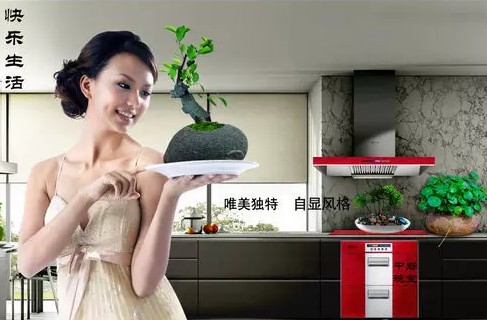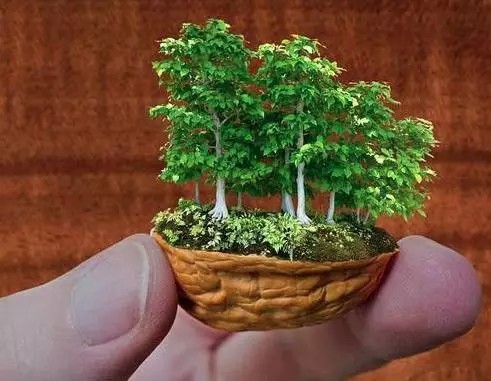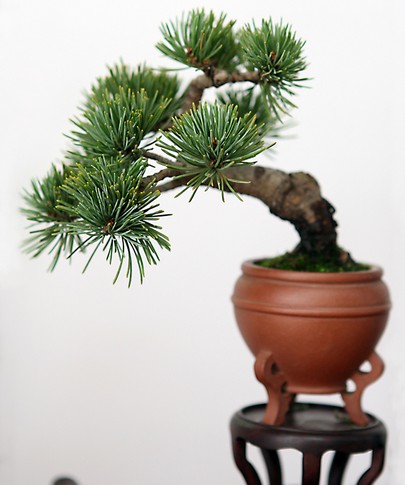Maintenance and management method of miniature bonsai
Miniature mini-bonsai although conditioning convenient, but not easy to maintain. Miniature potted plants especially need careful care. Pot soil should always keep moist, to see dry see wet, or with pot immersion irrigation. In summer, place in shade, spray water from a fine hole watering can on the plants to keep them moist. During the growth period, thin fertilizer should be applied frequently, usually once every 10 days or so. Available fully decomposed bean cake water, hoof water, etc. It is also possible to apply all-element compound fertilizer, and it is best to use pot leaching method for fertilization.

Conservation and management is the premise of the growth and survival of green shoots, so it is necessary to master the characteristics of trees and their conservation related factors, such as temperature, light, ventilation, pot soil, watering, fertilization and pest control. Compared with large and medium-sized bonsai, miniature bonsai should be more careful, thoughtful and meticulous in nursing, especially in pot soil, water, fertilizer and pest control.
1, pot soil: soil is the basis for healthy plant growth, pot tree selection of soil generally requires moderate pH, loose fertile, drainage breathable humus soil.
Watering: Watering is the most basic link in the process of bonsai growth and survival care. It seems simple, but many bonsai enthusiasts miss this link, resulting in withered or poor growth of potted trees. Watering should pay attention to the method, pay attention to the following matters and watering principles: see dry see wet, not dry do not irrigate, irrigate thoroughly. Its "dry" is not dry, but to maintain a certain degree of moisture, micro-miniature bonsai pot small, less soil, special attention should be paid to observation, not dehydration.
(1) Time for watering. Generally eight in the morning and five in the evening is more appropriate, but if it is the twelfth month of winter, watering around noon is appropriate. Watering too late, bonsai wet, if cold, can lead to root frostbite, summer morning and evening watering is better. In addition, the climate varies from place to place and should be flexibly controlled.
(2) The watering method. Take a combination of root watering, watering immersion and spraying. The root directly drenches to the basin surface root to the basin bottom hole water seepage then. Submergence is to directly put the potted tree into a large basin or tank filled with water, submerge it and permeate it (the drainage hole of the basin bottom penetrates). This method is easy to permeate water, fast and convenient. It is a common watering method for miniature bonsai. Spraying is to spray water on branches and leaves regularly with sprayer. This method can not only slow down the drying environment, but also moisturize the new plant blank pile, promote sprouting and rooting, and keep the branches clean.
Fertilization: Fertilization is an important part of pot tree management and maintenance and an effective means of healthy growth, but excessive fertilization or improper use of fertilizer will cause fertilizer damage, resulting in pot tree damage or death, which must be taken seriously.
(1) Principles of fertilization. Apply more thin fertilizer, all fertilizers rot heat, late fertilizer dry water, first mix base fertilizer, then top fertilizer, more organic fertilizer, less or no inorganic fertilizer (inorganic fertilizer easy to make pot soil hardening, ammonia fertilizer, phosphorus fertilizer and potassium fertilizer combined
(2) Fertilization time. Combine the growth condition of tree and season timely fertilization. Fewer or no fertilization in the survival period of pile blank (refers to topdressing; more fertilization in the storage period and vigorous period of pile blank; frequent fertilization in spring and autumn; no fertilization in hot summer and severe winter (dormant period of potted trees).
(3) Fertilization methods. Wet application and dry application. Wet application is liquid fertilizer mixed with water, the ratio of fertilizer to water is 1:10, dry application can be directly scattered around the root of the pot tree or embedded in the pot soil (reduce peculiar smell and prevent loss).
4. Pest control: Now that agricultural science and technology are developed, new drugs emerge one after another. If you find pests and diseases, you can consult the crop hospital or the sales department of agricultural production materials, and you can buy medicine for treatment. For pests can also be combined with capture methods to eliminate it.
Time: 2019-06-04 Click:
- Prev

How to shape miniature bonsai
Miniature bonsai is one of the most popular bonsai schools today. It uses the basin small, the idea is exquisite, the modelling is beautiful, decorates the room, is full of vitality. Miniature bonsai is mainly composed of flowers and plants and decorated with small pieces such as mountains and rocks. it is more and more used in landscape design, landscape design and family appreciation.
- Next

How to select materials for making miniature bonsai
Miniature and miniature bonsai belong to small specifications in bonsai art works, with miniature bonsai being the most, generally below 10cm, it is called bonsai on the palm; miniature bonsai is 11cm~40cm (Note: the size of this book is height before, width after). It is because it is famous for being small, small and exquisite.
Related
- Fuxing push coffee new agricultural production and marketing class: lack of small-scale processing plants
- Jujube rice field leisure farm deep ploughing Yilan for five years to create a space for organic food and play
- Nongyu Farm-A trial of organic papaya for brave women with advanced technology
- Four points for attention in the prevention and control of diseases and insect pests of edible fungi
- How to add nutrient solution to Edible Fungi
- Is there any good way to control edible fungus mites?
- Open Inoculation Technology of Edible Fungi
- Is there any clever way to use fertilizer for edible fungus in winter?
- What agents are used to kill the pathogens of edible fungi in the mushroom shed?
- Rapid drying of Edible Fungi

